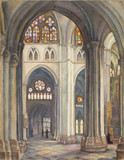Samuel Halpert was one of the first American artists to be exposed to European modernism and for a brief period was one of our more progressive painters. He studied in New York at the Educational Alliance and National Academy of Design from 1899 to 1902, continuing his training in 1902 at the Ecole des Beaux-Arts in Paris under Léon Bonnat (1833-1922). Within a year of his settling in France, where he lived for eight years, Halpert, along with his friend MAX WEBER, fell under the spell of successively more vanguard styles, from impressionism to fauvism and cubism. He fused modernist ideas onto a basically representational art rather than developing a revolutionary style. The work of Paul Cézanne (1839-1906) was very important to Halpert, whose landscapes and views of Paris and New York were often organized as studies of mass, space, and light. A more restrained version of Matisse’s and Marquet’s fauvism affected his palette.
Halpert returned to the United States in 1911, sharing a house with Man Ray (1890-1976) in New Jersey and becoming one of the few Americans to exhibit modernist paintings at the Armory Show. By 1919 his style had already lost much of its modernism, and during the succeeding decade it became increasingly academic. His interior and exterior views as well as his still-life paintings and figure studies continued a tendency toward simplified volume and structure despite their traditional style.
He found a receptive audience throughout his career, from his first solo exhibition at the progressive Daniel Gallery in 1914 to numerous exhibits at C. W. Kraushaar Galleries. In 1918 he married Edith Gregor, who through her Downtown Gallery in New York became one of the leading art dealers in American modernist art. Halpert was a member of the New Society of Artists and served as vice-president and director of the Society of Independent Artists, and during the last three years of his life he taught at the art school of the Society of Arts and Crafts in Detroit, Michigan.
BIBLIOGRAPHY
Archiv. Am. Art, Downtown Gallery Papers § Helen Comstock, "Samuel Halpert, Post-Impressionist," International Studio 75 (April 1922): 144-50 § Obituary, Art News 28 (April 12, 1930): 14 § New York, Bernard Black Gallery, Samuel Halpert, 1884-1930: A Pioneer of Modern Art in America, exh. cat., 1969, with chronology § Bernard Dorival, "L’Affaire Delaunay a l’Armory Show d’aprés des documents inèdits," Bulletin de la Société de l’Histoire de l’Art Français (1977): 323-32, with Halpert-Delaunay correspondence concerning modern art in New York, specifically the Armory Show.
